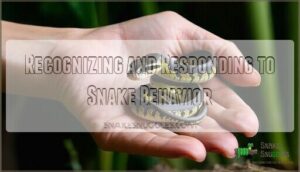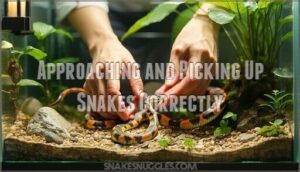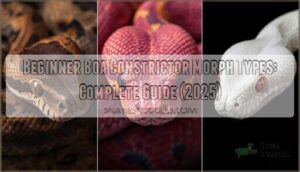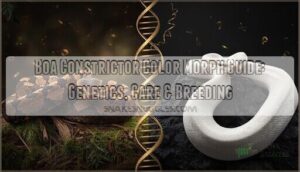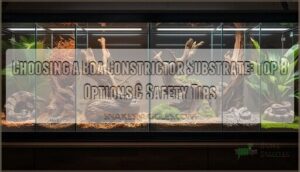This site is supported by our readers. We may earn a commission, at no cost to you, if you purchase through links.
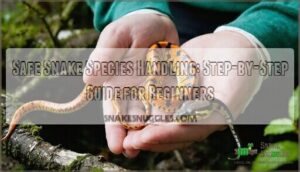
Safe snake species management isn’t just about confidence, it’s about consistent technique, proper equipment, and reading the subtle signals snakes give before they strike.
Whether you’re picking up your first corn snake or managing a collection, following proven protocols protects both you and the animal. The techniques you’ll learn here prevent the most common mistakes that turn routine interactions into emergency room visits.
Table Of Contents
- Key Takeaways
- Preparing for Safe Snake Handling
- Essential Equipment for Snake Handling
- Recognizing and Responding to Snake Behavior
- Step-by-Step Safe Handling Techniques
- Emergency Planning and Common Mistakes to Avoid
- Frequently Asked Questions (FAQs)
- How to handle a snake safely?
- How to handle a snake ethically?
- Why is safety equipment important when handling large snakes?
- What makes a good snake handler?
- Is snake handling a good experience?
- Why should you learn snake handling techniques?
- How often should snakes be handled weekly?
- Can multiple snakes be handled at once safely?
- What temperature range is best for handling snakes?
- How long should typical handling sessions last?
- Conclusion
Key Takeaways
- Most snake bites occur when experienced handlers become complacent, making consistent technique, proper equipment, and behavioral awareness more critical than confidence alone for safe interactions.
- Successful snake management requires matching species selection to your skill level (corn snakes, ball pythons, and king snakes are ideal for beginners), using appropriate protective gear including puncture-resistant gloves and snake hooks, and maintaining strict sanitization protocols to prevent disease transmission.
- Reading snake body language—including coiling posture, hissing, tail vibration, and species-specific stress signals—serves as your most reliable safety tool, while environmental factors like temperature, humidity, and shedding cycles directly influence whether snakes remain calm or turn defensive.
- Safe handling depends on proper timing (avoiding feeding days and shed cycles), supporting at least one-third of the snake’s body while keeping movements slow and deliberate, and limiting sessions to 10-15 minutes to prevent stress for both handler and snake.
Preparing for Safe Snake Handling
Before you bring a snake into your life, you need to get the groundwork right. This means taking an honest look at your skills, picking a species that matches your experience, and making sure everything from your enclosure to your gear is ready to go.
Here’s what you need to manage before your first interaction.
Assessing Your Experience and Comfort Level
Before you pick up your first snake, it’s worth taking an honest look in the mirror—not at your reflection, but at your readiness. Think about your comfort zones, experience levels, and personal boundaries regarding snake management. A proper risk assessment and skill evaluation will help you avoid snake safety mistakes. Here’s what matters:
- Your hands shake at the thought of touching scales
- You freeze when snakes move quickly without warning
- You can’t read snake behavior cues during management
- You skip protective gear because it feels unnecessary
Choosing The Right Snake Species for Beginners
Once you’re comfortable managing basics, you need the right snake species for your skill level. Snake temperament matters most—corn snakes, ball pythons, and king snakes rank as top beginner species because they tolerate manipulation well and show predictable snake behavior. Manipulation risks drop markedly when you match species selection to your experience.
Care requirements vary: ball pythons need higher humidity, while corn snakes adapt easily. These species rarely display aggression, making snake safety achievable as you develop proper manipulation techniques.
For a successful experience, research the best beginner snakes to guarantee compatibility with your skill level.
Setting Up a Secure and Safe Enclosure
Your chosen species needs a home that keeps both you and the snake secure during interaction sessions. Proper enclosure design prevents escapes and stress, making snake interaction techniques safer for everyone involved.
- Secure locking mechanisms prevent unexpected escapes—snakes are surprisingly strong
- Adequate ventilation systems maintain air quality without creating gaps
- Humidity control features support species-specific snake care needs
Snake enclosures with tight-fitting lids and reinforced seals offer escape prevention while you’re learning protective gear basics and snake safety protocols.
Sanitizing Hands, Gear, and Equipment
Before you reach for that snake, there’s one step many beginners skip that can make or break your management session—proper sanitation. Washing your hands with disinfectant removes residues and scents that stress snakes.
Use cleaning solutions on snake hooks and equipment; disinfection prevents cross-contamination between animals. Your hygiene protocols directly impact snake safety—clean gear maintenance protects both you and your reptile during management techniques.
Selecting and Using Personal Protective Equipment
Even with clean hands and sanitized tools, you’re not fully protected until you’ve layered on the right gear—think of it as your first line of defense when things don’t go as planned. Personal protective equipment shields you from bites and scratches during management sessions.
Choose gear that matches your snake species:
- Snake management gloves with puncture-resistant materials protect against teeth penetration
- Eye shields and protective masks guard against defensive strikes near your face
- Safety vests with hand guards and long sleeves cover vulnerable skin areas
Essential Equipment for Snake Handling
Having the right tools makes all the difference when you’re working with snakes. Quality equipment keeps you safe, gives you confidence, and helps you manage snakes without stressing them out.
Let’s look at what you’ll need and how to use it properly.
Snake Hooks and Their Proper Use
A snake hook acts like an extension of your hand, giving you the control and distance you need to move snakes safely without putting your fingers in harm’s way. Choose hooks made from stainless steel or aluminum for durability and easy sanitization.
Hook safety depends on proper technique—slide the hook gently under the snake’s midsection, about one-third back from the head, using smooth lifting motions.
Practice your snake management techniques with these management tools before working with live animals, and always pair hooks with other protective gear for complete snake management safety.
Puncture-Resistant Gloves and Protective Clothing
Your first line of defense against bites isn’t fancy equipment—it’s the barrier between your skin and a snake’s teeth, which makes gloves and protective clothing essential gear for every keeper. Choose puncture-resistant gloves made from leather or Kevlar for reliable hand safety and bite protection.
Layered clothing provides extra defense—wear long sleeves and sturdy pants that non-venomous snakes can’t easily penetrate, even though their teeth can break skin.
Protective suits offer full-body coverage during fieldwork, combining multiple clothing layers into one practical system for secure management techniques.
Protective Eyewear and Sturdy Footwear
Most people don’t think about their eyes and feet when managing snakes, but venom spray and a well-placed bite to your ankle can turn a routine session into a medical emergency.
Protective gear includes safety goggles that shield against spitting cobras and debris—critical eye protection during any management session.
High-top boots with thick soles provide essential footwear safety and snake bite prevention, covering vulnerable ankles where defensive strikes often land.
These safety measures and snake safety precautions complete your protective clothing arsenal, keeping you secure from head to toe.
Regular Maintenance and Sanitization of Tools
Dirty tools spread disease faster than most people realize, turning your snake hooks and gloves into silent vectors for respiratory infections, scale rot, and parasites.
That’s why cleaning protocols and tool disinfection matter—spray equipment with reptile-safe sanitizer types after each use, then store in a dry, ventilated space.
Follow maintenance schedules weekly for deep cleaning of protective gear, keeping your snake management and safety protocols airtight while protecting both you and your animals from cross-contamination.
Recognizing and Responding to Snake Behavior
Reading a snake’s body language isn’t guesswork—it’s your most reliable safety tool. Before you ever reach for a snake, you need to recognize what its posture, movement, and sounds are telling you.
The three key areas below will help you spot warning signs, understand what different species are communicating, and adjust your approach based on the environment.
Identifying Signs of Stress or Aggression
When a snake’s body goes rigid or its tail starts rattling like an alarm bell, you’re looking at nature’s way of saying "back off now." These stress signals and aggression cues demand immediate attention.
Watch for these defensive postures:
- Coiling tight with the head raised, ready to strike
- Hissing or mouth gaping to display threat responses
- Tail vibration mimicking a rattlesnake’s warning
- Flattened neck or body making themselves appear larger
Reading snake body language keeps you safe and reduces their stress.
Understanding Species-Specific Behavioral Cues
Every snake species speaks its own language, and missing those cues can turn a routine interaction into a defensive strike. Ball pythons coil into tight balls when threatened, while corn snakes prefer freezing or darting away. Recognizing these behavioral patterns helps you manage each species securely.
Understanding snake body language through species recognition keeps you one step ahead. These behavioral patterns reveal what your snake needs before aggression escalates. Understanding snake patterns, such as snake camouflage techniques, is vital for secure management.
| Species | Defensive Postures | Stress Signals |
|---|---|---|
| Ball Python | Coils into tight ball, hides head | Refuses food, constant hiding |
| Corn Snake | Freezes, then vibrates tail | Rapid tongue flicking, restlessness |
| King Snake | Musks, vibrates tail rapidly | Biting, thrashing movements |
| Boa Constrictor | Hisses loudly, strikes repeatedly | Body tension, refusing to relax |
| Garter Snake | Releases musk, attempts escape | Constant movement, defecation |
Environmental Factors Affecting Snake Behavior
Temperature and humidity don’t just affect your snake’s comfort—they directly shape whether it stays calm or turns defensive during contact. Cold temperatures slow metabolism and trigger lethargy, while excessive heat causes agitation and striking behavior.
Humidity levels determine shedding cycles—snakes in shed become temporarily blind and unpredictable. Lighting effects and spatial layout within enclosures influence stress responses, making climate adaptation critical for safe interactions.
Understanding environmental science principles in herpetology ensures you recognize when snake body language shifts from relaxed to defensive, protecting both caretaker and animal during wildlife conservation efforts.
Step-by-Step Safe Handling Techniques
Once you understand the basics of snake behavior, you’re ready to practice the actual management process.
The techniques below break down each step, from your initial approach to supporting the snake’s body properly. Following these steps carefully will help you build confidence while keeping both you and the snake safe.
Approaching and Picking Up Snakes Correctly
The moment you reach toward a snake, everything about your approach—your speed, angle, and confidence—determines whether the interaction stays calm or turns defensive.
Move slowly and deliberately, giving the snake time to register your presence. Approach from the side rather than directly above, which can trigger a predator response. Use calm approach methods and keep your movements smooth, not jerky.
Once close, gently slide one hand under the midsection while keeping your other hand ready for support—this shows proper safe grip techniques and guarantees snake management safety from the start.
Supporting The Snake’s Body and Avoiding The Head
Once you’ve got a secure hold, your priority shifts to distributing the snake’s weight evenly across both hands—never letting its body dangle unsupported or allowing your grip to drift too close to the head. Proper body support and a firm midsection grip are essential snake management techniques that prevent injury to both caretaker and snake.
Keep these safe management techniques in mind:
- Support at least one-third of the snake’s body length at all times
- Avoid the head area to prevent triggering defensive snake body language
- Let the snake move freely through your hands rather than using snake restraint
This gentle management approach guarantees snake management safety while respecting the animal’s natural behavior.
Using Calm, Gentle Movements to Prevent Stress
Your hands are the snake’s lifeline—sharp jerks or rushed grabs can flip calm curiosity into defensive panic in seconds. Slow, predictable movements telegraph your intentions, giving the animal time to adjust without triggering stress responses.
A calm approach with gentle management reduces defensive snake behavior, while movement control keeps interactions smooth. Let the snake glide through your hands at its own pace—this stress reduction technique respects snake comfort and builds trust. Safe management techniques prioritize the animal’s rhythm over yours.
Safe Handling Times and Avoiding Stressful Periods
Timing isn’t just a detail—it’s often the deciding factor between a cooperative snake and a defensive one ready to strike. Safe Interaction Times align with your snake’s natural rhythms, respecting Environmental Triggers that shape snake behavior. Avoid interaction during shedding cycles or feeding days, when Snake Stress Signs multiply and defensive reactions peak.
Key timing guidelines for safe interaction techniques:
- Wait 48 hours post-feeding to prevent regurgitation stress
- Skip interaction during shed cycles when vision dims and anxiety spikes
- Choose midday sessions when temperatures stabilize snake body language
- Limit sessions to 10-15 minutes to maintain trust without fatigue
Emergency Planning and Common Mistakes to Avoid
Even the most careful caretaker can face unexpected situations, so knowing what to do when things go wrong is just as important as perfecting your technique.
You’ll also want to recognize the common pitfalls that trip up beginners—mistakes that can compromise safety for both you and the snake.
Let’s look at how to prepare for emergencies and sidestep the errors that often lead to trouble.
Differentiating Venomous and Non-Venomous Bites
If you’ve just been bitten, knowing whether venom was injected can make all the difference in your emergency response. Venomous snake bites usually leave two distinct puncture marks and cause rapid swelling within 15 to 120 minutes, while non-venomous bites show multiple small punctures in an arc pattern with minimal tissue reaction.
Watch for bite symptoms like persistent bleeding, neurotoxic signs such as drooping eyelids, or systemic effects including difficulty breathing—these signal venomous snake identification is critical. Non-venomous snakes produce only localized pain without the severe venom effects seen in true envenomation.
Understanding snake behavior and recognizing these differences guides appropriate snake bite treatment and ensures you respond correctly.
First Aid Steps for Snake Bites
If snake bite first aid isn’t managed correctly, venom removal attempts can worsen the situation. Stay calm, immobilize the affected limb below heart level, and remove jewelry or tight clothing before swelling starts.
Don’t try to suck out venom or apply ice—clean the wound gently with soap and water, watch for bite symptoms like swelling or difficulty breathing, and get to a hospital immediately.
Keep your first aid kit stocked and ready for quick medical response.
Creating and Following an Emergency Response Plan
Having a solid emergency plan before you manage any snake isn’t just smart—it’s what separates a controlled incident from a full-blown crisis.
Write down emergency procedures, stock first aid kits with clean bandages and antiseptic, save local hospital numbers for venomous snake management incidents, and drill your response teams on safety protocols and crisis management steps before you ever pick up a snake.
Frequent Handling Mistakes and How to Prevent Them
Even experienced keepers slip into bad habits that put them—and their snakes—at unnecessary risk, but spotting these patterns early can save you from a painful lesson. Common management errors include grabbing near the head, jerking movements that spike snake stress, and skipping pre-management checks that aid bite prevention.
Master safe management techniques by supporting the body fully, moving slowly, and following safety protocols consistently—your mistake analysis starts with recognizing what went wrong before it happens.
Frequently Asked Questions (FAQs)
How to handle a snake safely?
Steady hands win the day when fear strikes—slow your roll, support the body, and read the room before reaching in.
Proper grip and body support matter most; use a calm approach and gentle movements to avoid startles during snake management.
Master safe management techniques with protective gear, especially when managing venomous snakes, to guarantee snake safety.
How to handle a snake ethically?
Ethical management means prioritizing snake welfare through humane capture and gentle restraint. Responsible ownership demands you understand snake behavior, use proper management techniques, and minimize stress.
Ethical snake management practices respect the animal’s needs over convenience.
Why is safety equipment important when handling large snakes?
Large snakes pack serious strength, and safety gear like puncture-resistant gloves, sturdy boots, and protective clothing shields you from injury during manipulation.
Emergency kits and proper protective measures guarantee you’re prepared when unexpected reactions happen, making large snake manipulation safer for everyone involved.
What makes a good snake handler?
Patience isn’t just virtue—it’s your anchor when things get slithery.
Patience isn’t just a virtue when handling snakes—it’s the anchor that keeps you steady when instinct screams to panic
A good snake manager combines calm demeanor with sharp risk awareness, built on solid species knowledge and practiced management skills.
Your understanding of snake behavior guides safe management techniques, whether you’re working with docile pets or learning venomous snake management under supervision.
Is snake handling a good experience?
When done right, managing snakes offers emotional rewards and builds confidence while teaching risk awareness and respect for wildlife.
You’ll develop patience, overcome management fears through snake interaction, and gain insight into snake behavior—all while applying secure management techniques and snake management safety principles.
Why should you learn snake handling techniques?
Learning proper snake management techniques is vital for wildlife education, animal welfare, and secure management methods. Whether you’re involved in reptile research, herpetology benefits, or snake conservation, these skills protect both you and the snake while advancing responsible wildlife education.
How often should snakes be handled weekly?
Think of interaction like a handshake—too frequent and it becomes intrusive.
You should interact with your snake once or twice weekly for 10-15 minutes, allowing adequate rest between sessions to minimize snake stress and maintain proper interaction limits while practicing secure interaction techniques.
Can multiple snakes be handled at once safely?
You shouldn’t manage multiple snakes at once. Managing several snakes at the same time compromises your safety protocols and ability to read individual behavior, increasing bite risk markedly. Focus on one snake per management session for proper concurrent care and control.
What temperature range is best for handling snakes?
Your best window for management sits between 75 and 85 degrees Fahrenheit, where thermal safety meets natural snake thermoregulation needs.
Temperature control in management environments directly affects snake behavior, keeping your reptile calm and responsive during snake care sessions.
How long should typical handling sessions last?
You should keep sessions brief, around ten to fifteen minutes for most snakes. Shorter interaction limits reduce snake fatigue and stress, while safety intervals between interactions help your snake recover.
Think of it like a conversation—you don’t want to overstay your welcome. Watch for signs of restlessness or tension, and always end on a calm note.
Conclusion
Back in the telegraph days, operators knew a single mistake could mean disaster—snake management demands the same vigilance. Every time you approach your enclosure, remember that safe snake species management isn’t about memorizing steps, it’s about building instincts through repetition.
Your hands will learn to read tension before your eyes spot defensive posturing. Mistakes don’t announce themselves with fanfare; they slip in during the moment you stop thinking. Stay deliberate, stay present, and your confidence will grow without complacency tagging along.
- https://www.merckmanuals.com/home/quick-facts-injuries-and-poisoning/bites-and-stings/snakebites
- https://pmc.ncbi.nlm.nih.gov/articles/PMC7690386/
- https://www.who.int/news-room/fact-sheets/detail/snakebite-envenoming
- https://journals.plos.org/plosntds/article/file?id=10.1371%2Fjournal.pntd.0009464&type=printable


